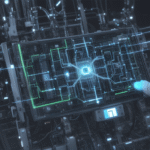Introduction to Quantum Computing
In simple terms, quantum computing is a type of computing that uses quantum-mechanical phenomena, such as superposition and entanglement, to perform operations on data. While traditional computers use bits (0s and 1s) to process information, quantum computers use qubits, which can exist in multiple states simultaneously.
This unique property allows quantum computers to solve certain problems much faster than traditional computers. For example, they could factor large numbers or search through vast databases exponentially faster. However, quantum computing is still largely in its infancy, and practical applications are limited due to challenges like error rates and the need for specialized hardware.
What Is Biometric Authentication?
Biometric authentication is a method of verifying someone’s identity based on their unique physical or behavioral characteristics. Common examples include:
- Fingerprints: Unique patterns of ridges and valleys on your fingertips
- Facial Recognition: Identifying individuals based on unique features in their faces
- Iris Scanning: Examining the unique patterns in a person’s iris
- DNA Matching: Comparing genetic material to identify individuals
Biometric authentication is widely used in security systems, such as unlocking smartphones or granting access to government databases. However, these systems often face challenges like high costs, privacy concerns, and potential for misuse.
Quantum-Enhanced Biometric Authentication: The Concept
Quantum-enhanced biometric authentication combines the principles of quantum computing with biometric technology to create more secure, accurate, and efficient authentication methods. The idea is to leverage quantum properties—such as superposition and entanglement—to improve the performance of traditional biometric systems.
Here’s how it might work:
- Improved Accuracy: Quantum computers can process vast amounts of data simultaneously, potentially making biometric systems more accurate by analyzing unique patterns at a much faster rate.
- Enhanced Security: Quantum computing could be used to encrypt biometric data or verify its authenticity without compromising the privacy of the user.
- Faster Processing: Quantum-enhanced systems could process biometric data much more quickly than traditional systems, making authentication faster and more convenient for users.
How Quantum Computing Affects Biometric Authentication
To understand how quantum computing impacts biometric authentication, let’s break it down:
Quantum Bits (Qubits) vs. Classical Bits
- Classical Bits: Traditional computers use bits (0s or 1s) to represent data and perform computations.
- Qubits: Quantum computers use qubits that can exist in multiple states simultaneously due to superposition. This allows quantum computers to process vast amounts of data at once.
Quantum Entanglement
Entanglement is a phenomenon where two particles become interconnected, such that the state of one particle instantly influences the state of another, no matter the distance between them. In biometric authentication, entanglement could be used to create highly secure and reliable verification systems by linking large datasets together.
Quantum Error Correction
Traditional computers are prone to errors due to hardware limitations and noise. Quantum computers are particularly susceptible to errors due to their delicate nature. However, quantum error correction techniques could make biometric authentication more robust by ensuring data integrity during the authentication process.
Scenarios for Quantum-Enhanced Biometric Authentication
To help you visualize how these systems might work in real-world scenarios:
Scenario 1: Secure Financial Transactions
Imagine a quantum-enhanced facial recognition system used to verify customers at a bank’s ATM. Instead of storing and comparing raw facial data, the system could use quantum computing to create an encrypted, highly detailed profile of your face that is nearly impossible to
replicate without access to the correct biometric data.
Scenario 2: Healthcare Access
A hospital could use quantum-enhanced iris scanning technology to verify the authenticity of a patient’s iris. The quantum system would generate a unique, unbreakable identifier for each iris based on its atomic structure, ensuring secure and accurate identity verification.
Scenario 3: Government Identification Systems
Government agencies might implement quantum-enhanced fingerprint recognition systems to verify the authenticity of legal documents or identification cards. By using quantum computing to enhance fingerprint analysis, these systems could achieve higher levels of accuracy
while protecting sensitive personal information.
The Benefits of Quantum-Enhanced Biometric Authentication
Quantum-enhanced biometric authentication offers several advantages over traditional methods:
- Increased Security: The unique properties of quantum mechanics make it difficult for hackers or malicious actors to replicate or steal the biometric data used in authentication.
- Higher Accuracy: Quantum computers can process massive datasets simultaneously, potentially improving the accuracy of biometric systems by identifying minute differences in biometric traits that might be missed by traditional methods.
- Faster Processing: By leveraging quantum computing’s speed, these systems could verify credentials or access much more quickly than traditional systems, enhancing user experience
The Challenges of Quantum-Enhanced Biometric Authentication
While the benefits of quantum-enhanced biometric authentication are significant, there are also some challenges to consider:
- Complexity: Quantum computing is still in its early stages, and implementing it within biometric systems requires substantial investment in technology and expertise.
- Privacy Concerns: The use of advanced quantum algorithms could potentially be misused by malicious actors for surveillance or data mining. Ensuring privacy and security remains a top priority
- Standardization: There is currently no standardized protocol for quantum-enhanced biometric authentication, which could lead to compatibility issues across different systems and devices.
How to Get Started with Quantum-Enhanced Biometric Authentication
If you’re interested in exploring quantum-enhanced biometric authentication, here are some steps you can take:
- Learn the Basics of Quantum Computing: Start with introductory resources on quantum mechanics, qubits, and quantum algorithms to understand how they work.
- Explore Quantum-Safe Biometric Solutions: Look into companies or platforms that offer quantum-safe biometric verification tools designed to work with existing infrastructure
- ** experiment with Quantum Simulators**: Use online quantum computing simulators like IBM Qiskit to experiment with basic quantum algorithms and see how they could be applied to biometric systems
- Stay Updated on Industry Developments: Follow technology blogs, news outlets, and industry reports to stay informed about the latest advancements in quantum computing and biometric authentication
Conclusion: The Future of Biometric Authentication
Traditional biometric authentication methods have proven valuable for many applications, but they often come with their own set of challenges. Quantum-enhanced biometric authentication offers a promising solution by combining the strengths of quantum computing and biometric technology to create more secure, accurate, and efficient authentication systems.
While there are still hurdles to overcome, the potential benefits make this an exciting area of research and development for cybersecurity professionals, technologists, and policymakers. As quantum computing continues to evolve, we may see even more innovative applications of biometric authentication in fields like healthcare, finance, government, and beyond.
If you’re curious about how these technologies might intersect, start by exploring open-source quantum-safe biometric libraries or platforms designed to support quantum-enhanced authentication. For a comprehensive guide on implementing biometric security systems, check out our article “Biometric Authentication: Everything You Need to Know.”







